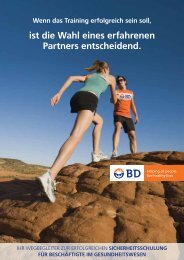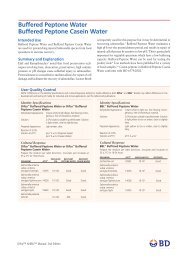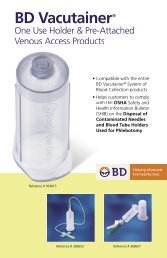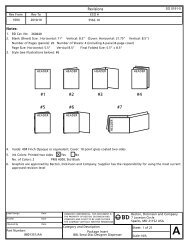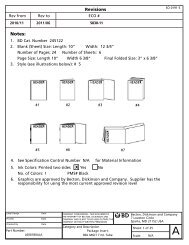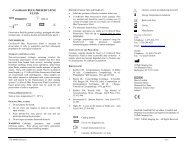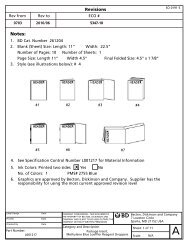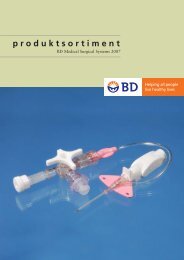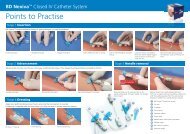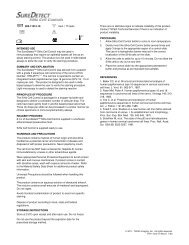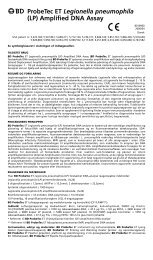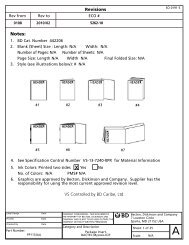BD Vialon
BD Vialon
BD Vialon
You also want an ePaper? Increase the reach of your titles
YUMPU automatically turns print PDFs into web optimized ePapers that Google loves.
<strong>BD</strong> <strong>Vialon</strong> TM<br />
Biomaterial<br />
The Material Difference in Vascular Access
<strong>BD</strong> <strong>Vialon</strong> <br />
B I O M A T E R I A L<br />
C l i n i c a l l y S u p e r i o r<br />
The Difference is<br />
<strong>BD</strong> <strong>Vialon</strong> Biomaterial<br />
<strong>BD</strong> <strong>Vialon</strong> Biomaterial is a<br />
unique, proprietary biomaterial,<br />
developed over a decade ago,<br />
especially for vascular access.<br />
<strong>BD</strong> <strong>Vialon</strong> biomaterial has been<br />
proven to enhance clinical and<br />
economic outcomes.<br />
Multiple clinical investigations<br />
conducted over ten years have<br />
demonstrated that IV catheters<br />
made of <strong>BD</strong> <strong>Vialon</strong> biomaterial<br />
proved easier to insert, while<br />
providing longer indwelling times<br />
with improved patient outcomes.<br />
A Smooth and Easy Insertion<br />
The insertion<br />
characteristics<br />
of <strong>BD</strong> <strong>Vialon</strong><br />
biomaterial<br />
catheters are<br />
as unique as<br />
the material itself. Superior tip<br />
integrity, an ultra-smooth microsurface<br />
and an exclusive lubrication<br />
process enable the easiest<br />
insertion possible, making<br />
<strong>BD</strong> <strong>Vialon</strong> biomaterial catheters<br />
easier to place and advance on a<br />
wider cross-section of patients. 1<br />
<strong>BD</strong> Insyte I.V. Catheter<br />
Before Insertion<br />
(75X enlargement)<br />
<strong>BD</strong> Insyte I.V. Catheter<br />
After Insertion<br />
(75X enlargement)<br />
Softens Inside the Vessel<br />
Another distinctive characteristic<br />
of <strong>BD</strong> <strong>Vialon</strong> biomaterial is its<br />
ability to soften up to 70% while<br />
in the vessel. 5<br />
By conforming to the shape of<br />
the vein, catheters made of<br />
<strong>BD</strong> <strong>Vialon</strong> biomaterial reduce<br />
the chance of irritation to the<br />
vessel wall, which in turn<br />
reduces the incidence of<br />
mechanical phlebitis, a major<br />
complication of IV therapy.<br />
<strong>BD</strong> <strong>Vialon</strong> Biomaterial<br />
FEP Polymer
Catheters made of <strong>BD</strong> <strong>Vialon</strong> biomaterial are<br />
clinically proven to optimize patient outcomes.<br />
Ease of<br />
Insertion<br />
Optimum Ease of Insertion<br />
The sharp needle and patented<br />
catheter tip taper enable a smooth<br />
penetration through the skin and<br />
into the vessel.<br />
Results: “Ease of penetration<br />
through the skin was signifi cantly<br />
better with the <strong>Vialon</strong> cannulae.” 1<br />
“Cannula tip damage was more<br />
common with the Tefl on cannulae<br />
(37.3%) than with the <strong>Vialon</strong> cannulae<br />
(16.6%). This tip damage<br />
was signifi cantly associated with<br />
higher mean phlebitis scores.” 1<br />
Optimum Kink Resistance<br />
The <strong>BD</strong> <strong>Vialon</strong> biomaterial is signifi<br />
cantly more fl exible than other<br />
IV catheter materials. 5<br />
Results: “Kinking was not found<br />
in any of the <strong>Vialon</strong> cannulae after<br />
removal. However, 29.3% of the<br />
Tefl on cannulae had visible kinks<br />
of the cannula shaft, usually at its<br />
junction with the hub.” 2<br />
Reduced Risk<br />
Kink<br />
+ Resistance + of Mechani-<br />
Risk of IV + =<br />
cal Phlebitis<br />
Optimum Reduced Risk of<br />
Mechanical Phlebitis<br />
“Our data suggest a cost-effective<br />
strategy for the use of intravenous<br />
catheters to minimize the risk<br />
for phlebitis ... for most patients<br />
requiring prolonged peripheral<br />
venous access, PEU-<strong>Vialon</strong> catheters<br />
replaced every 3 or 4 days<br />
would produce a lower incidence<br />
of phlebitis than would FEP-<br />
Tefl on catheters replaced every 2<br />
days.” 2<br />
Results: “... catheters made of<br />
PEU-<strong>Vialon</strong> were substantially<br />
less phlebitogenic than were catheters<br />
made of FEP-Tefl on: The<br />
reduction in risk was nearly 30%<br />
overall; in severe phlebitis, the<br />
reduction was nearly 50%.” 2<br />
“… the nature of the cannulae was<br />
the single most important factor<br />
in the incidence and severity of<br />
infusion thrombophlebitis, <strong>Vialon</strong><br />
cannulae being associated with<br />
a 46% lower incidence than the<br />
Tefl on type.” 1<br />
“… the incidence of phlebitis in<br />
the group receiving <strong>Vialon</strong> I.V.<br />
catheters was 36 percent lower<br />
than that of the group receiving<br />
Tefl on I.V. catheters.” 4<br />
Reduced<br />
Infi ltration<br />
Optimum<br />
Indwelling<br />
Time<br />
Optimum Reduced Risk<br />
of IV Infi ltration<br />
Due to the superior softening<br />
capabilities of the <strong>BD</strong> <strong>Vialon</strong><br />
biomaterial, it conforms to the<br />
natural lie of the vessel, resulting<br />
in less pressure to the vessel walls,<br />
thereby reducing the risk of vessel<br />
wall penetration by the catheter<br />
material.<br />
Results: “These multivariate<br />
models showed that <strong>Vialon</strong><br />
catheter material reduced the risk<br />
of infi ltration by 18%... in the<br />
total sample and by 35%... in the<br />
higher risk low-weight (≤ 1500 g)<br />
subsample.” 3<br />
1 P.B. Gaukroger, J.G. Roberts, and T.A. Manners.<br />
“Infusion Thrombophlebitis: A Prospective Comparison<br />
of 645 <strong>Vialon</strong>® and Tefl on® Cannulae in<br />
Anaesthetic and Postoperative Use” Anaesthesia<br />
and Intensive Care, August 1988, Volume 16,<br />
No.3.<br />
2 Dennis Maki, MD and Marilyn Ringer, BSN, MS.<br />
“Risk Factors for Infusion-related Phlebitis with<br />
Small Peripheral Venous Catheters” Annals of<br />
Internal Medicine, 1991; 114:845-854.<br />
3 Michael Stanley, MD, Emily Meister, RNC and<br />
Kathryn Fuschuber, RN. “Infi ltration During<br />
Intravenous Therapy in Neonates: Comparison of<br />
Tefl on® and <strong>Vialon</strong>® Catheters” Southern Medical<br />
Journal, September 1992, Volume 85, Number<br />
9, Pages 883-886.<br />
4 Joy M. McKee, RN, OCN, Judith A. Shell, RN,<br />
MSN, OCN, Teresa A. Warren, RN, CIC, and V.<br />
Paula Campbell, RN, OCN. “Complications of<br />
Intravenous Therapy: A Randomized Prospective<br />
Study – <strong>Vialon</strong> vs. Tefl on” Journal of Intravenous<br />
Nursing, Vol. 12, No. 5, Sept./Oct. 1989.<br />
5 Data on fi le.
With <strong>BD</strong> <strong>Vialon</strong> Biomaterial,<br />
You’re Sure to Save<br />
The <strong>BD</strong> SureSave TM<br />
Analysis offered<br />
by <strong>BD</strong> Medical will show<br />
how catheters made of<br />
<strong>BD</strong> <strong>Vialon</strong> biomaterial can reduce<br />
the total cost of IV therapy by<br />
enhancing fi rst-start effi ciency,<br />
reducing restarts and increasing<br />
indwelling times.<br />
<strong>BD</strong> <strong>Vialon</strong> <br />
B I O M A T E R I A L<br />
C l i n i c a l l y S u p e r i o r<br />
Ask for Catheters<br />
Made of <strong>BD</strong> <strong>Vialon</strong> Biomaterial<br />
<strong>BD</strong> <strong>Vialon</strong> biomaterial catheters<br />
are available exclusively from <strong>BD</strong>.<br />
The following product lines are<br />
available in a variety of lengths<br />
and gauges:<br />
<strong>BD</strong> Insyte TM<br />
Shielded IV Catheters<br />
Autoguard TM<br />
<strong>BD</strong> Saf-T-Intima TM<br />
Closed IV Catheter System<br />
<strong>BD</strong> Medical<br />
9450 South State Street<br />
Sandy, Utah 84070<br />
1-888-237-2762<br />
www.bd.com/infusion<br />
<strong>BD</strong>, <strong>BD</strong> Logo and all other trademarks are<br />
property of Becton, Dickinson and Company.<br />
©2006 <strong>BD</strong>.<br />
D12907-2 B(2-06)



